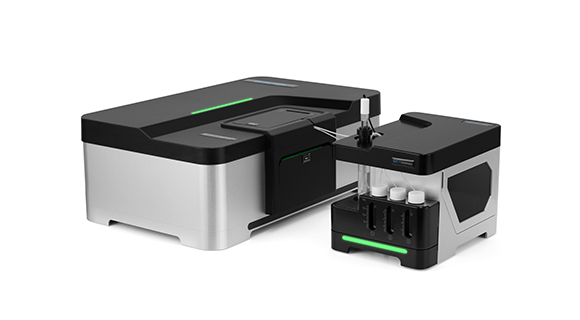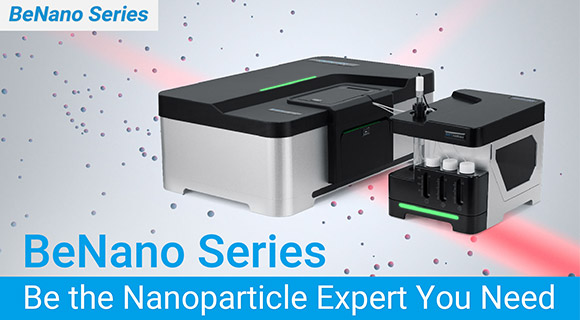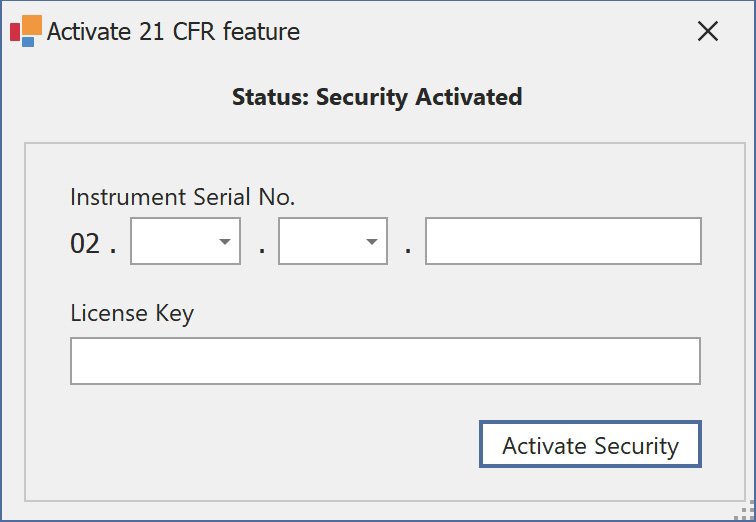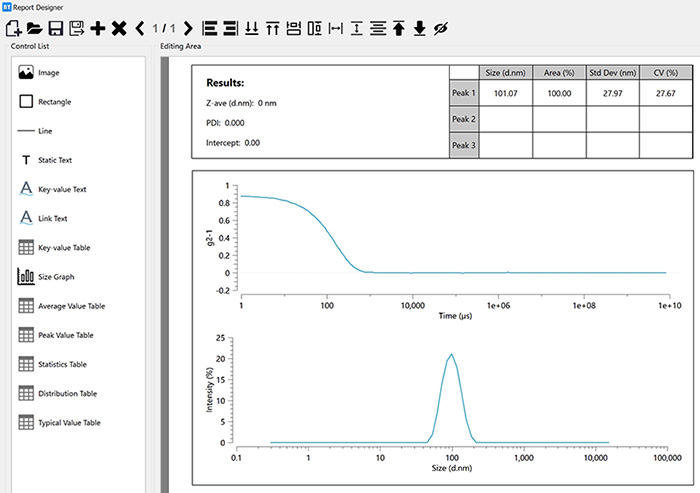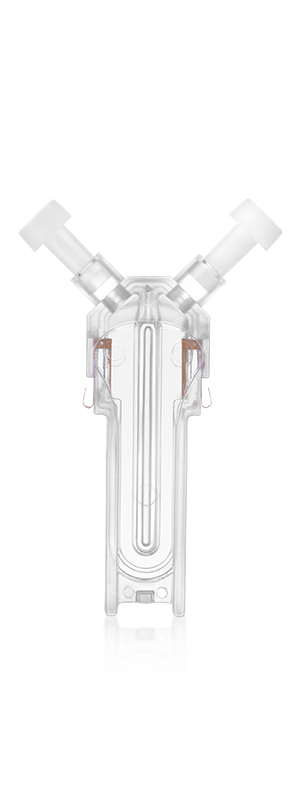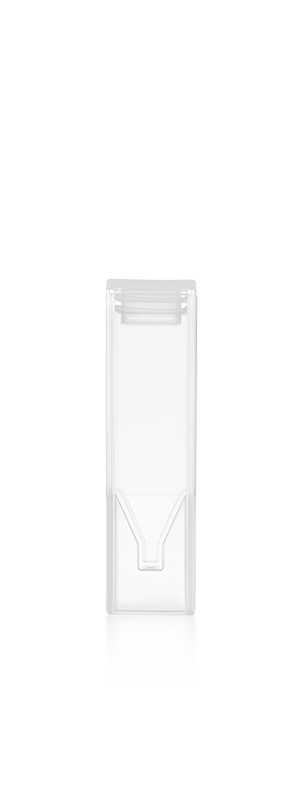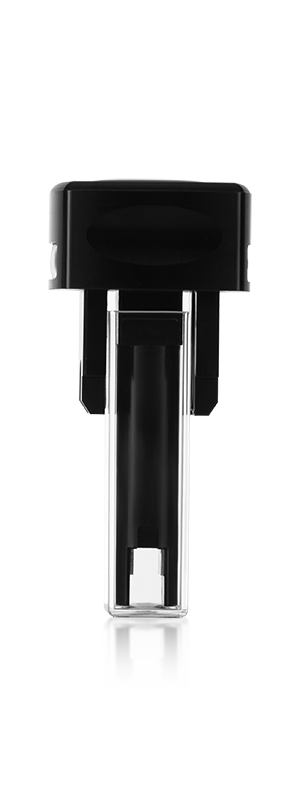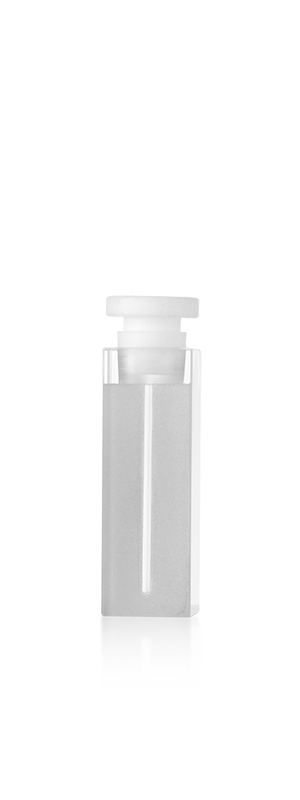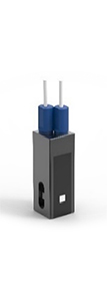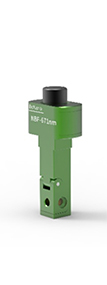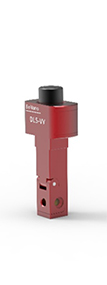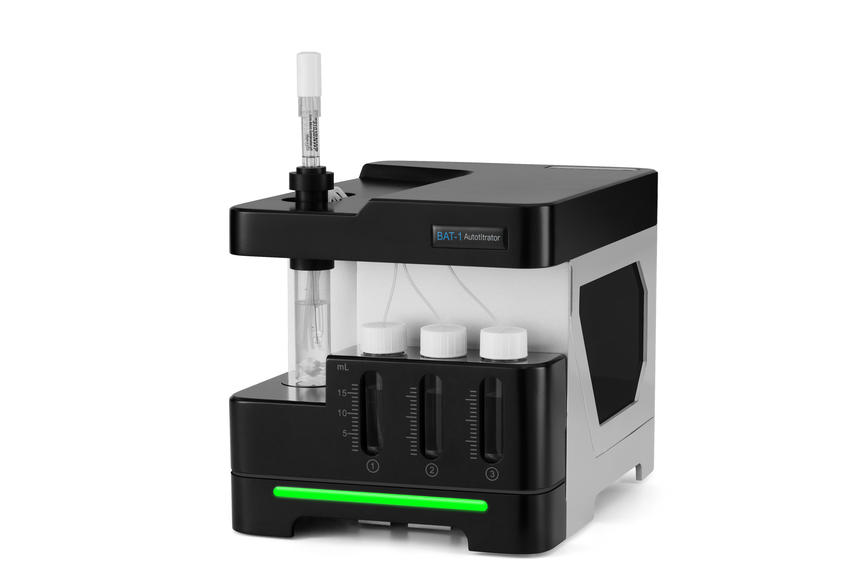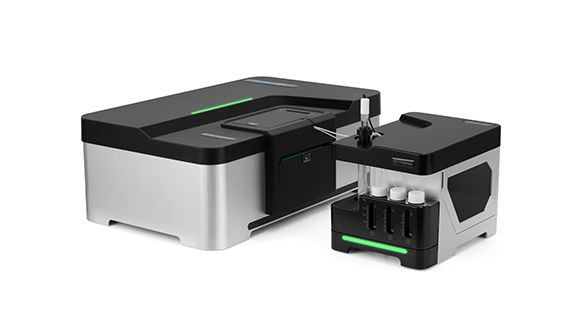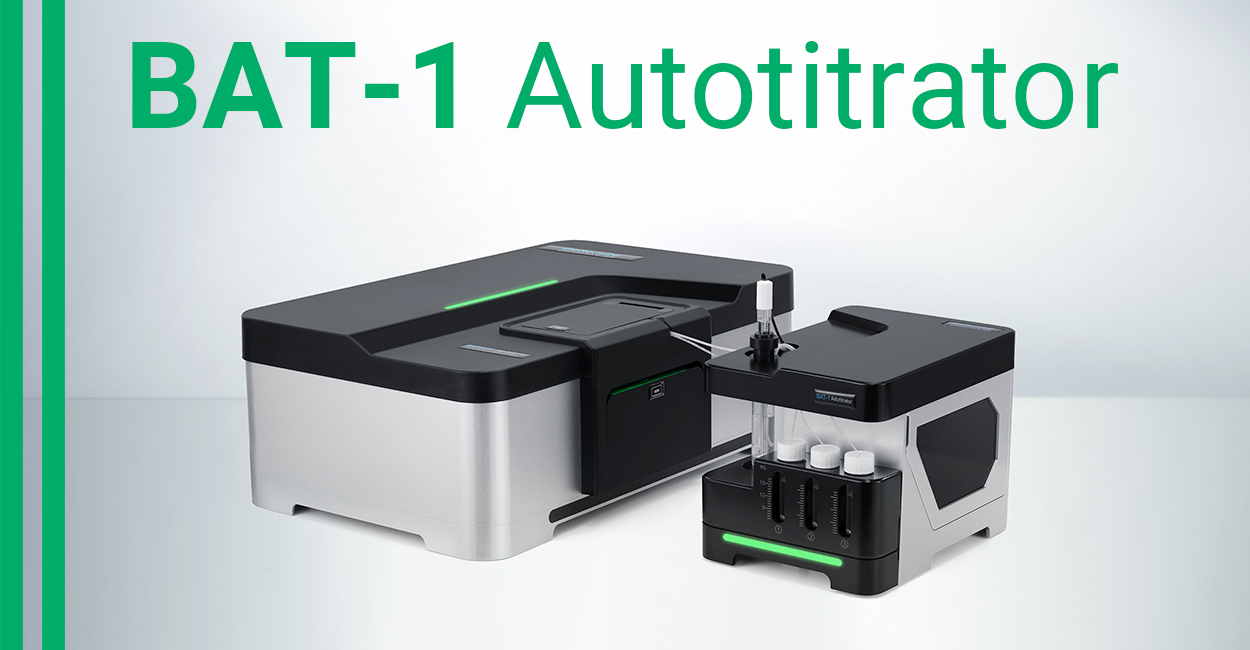粒子径、ゼータ電位、分子量、レオロジー特性は、ナノ粒子評価における重要な指標です。最先端技術を搭載したナノ粒子分析装置BeNanoシリーズにより、ナノ粒子の評価をより高感度、高精度に測定します。
機能と利点
- ● 測定範囲:0.3nm〜15μm
- ● 極少量サンプル(3-5μL)対応可
- ● 最新型APDにより感度アップ
- ● 散乱量に応じてレーザー強度を自動調整
- ● インテリジェントなアルゴリズムを採用し、埃の干渉効果を抑制
- ● 後方光散乱(173°)検出技術と最適な検出位置のインテリジェント調整
- ● 塩濃度の高いサンプルや等電点付近での高精度測定が可能
- ● PALS(光散乱位相解析)技術でブラウン運動の影響を低減
- ● 測定温度:-15℃~110℃で設定可能
- ● ISO 22412、ISO 13099を準拠
ビデオ
Enhanced Size Resolution with DLS Flow Mode 
BeNano 90 Zeta | Demo (Polystyrene Standard Sample) 
Fundamentals of BeNano 90 Zeta 
BeNano 90 Zeta | Nanoparticle size and zeta potential analyzer 
BeNano Series | Customer Perspective & Demo 
Understanding the DLS Backscattering Technology 
Book a Free Demo with Global Distributors 
BeNano 180 Zeta Pro | Demo (Polystyrene Latex Sample) 
BeNano 180 Zeta Pro | Nanoparticle size and zeta potential analyzer 
BeNano 180 Zeta Pro Launch Event | Nanoparticle size and zeta potential analyzer 
4 Questions Nanoparticle Researchers are Really Asking About 
Fundamentals of BeNano 180 Zeta Pro 
Fundamentals of BAT 1 Autotitrator 
Fundamentals of DLS Microrheology 
How to Measure Microrheological Properties of Liquids by BeNano? 
How to Operate BAT 1 Autotitrator to Measure Zeta Potential vs. pH 
Fundamentals of BeNano 180 Zeta Pro 
概要
BeNanoで研究の可能性を広げる
- 光散乱位相解析(PALS)技術によりゼータ電位の高精度測定
通常のELS では、散乱信号を周波数分布に変換してから、参照光と比較した散乱光の周波数シフトΔ f を計算しますが、PALS技術は、元の散乱信号の位相情報Φを分析して光の周波数情報を取得する技術です。粒子のブラウン運動の影響を抑制することで高い統計精度を提供でき、等電点付近や、高塩濃度でも測定を可能にします。
- 173°後方光散乱検出技術と最適な検出位置のインテリジェント調整
173°の後方光散乱量は90°の光散乱量に比べ8~10倍大きくなり、以下のメリットがあります。
-
- 非常に薄いサンプル濃度(0.1ppm)の高精度測定
- 多重散乱を回避し、40%w/vの高濃度まで測定可能
- 埃の干渉効果の抑制
- 幅広い温度範囲:-15℃~110℃
高精度温度制御が可能で、低温(結露防止のために乾燥空気あるいは窒素ガス必要)~高温まで温度制御が可能です。温度変化に伴ってBSAタンパク質が変性が起こっていることが観測できます。このように温度を変えながら各種サンプルの安定性における温度依存性を評価できます。
- 優れた光学システム
50mW固体レーザー、シングルモードファイバーシステム、高性能APD検出器を採用し、広範囲かつ感度の高い検出能力を提供します。
- 研究用ソフトウェア
BeNanoソフトウェアは、散乱光信号をインテリジェントに評価・処理し、S/N比と結果の安定性を向上させます。様々な計算モードを内蔵しており、様々な科学研究や応用分野に対応できます。
- 極少量サンプル(3-5μL)対応可
専用のキュベットを用いることで、希少なサンプルの粒子径を測定することが可能です。
1. 動的光散乱法(DLS)による粒子径測定
ブラウン運動をする粒子系の散乱強度は、粒子の運動速度、すなわち粒子径に応じたゆらぎをもちます。動的光散乱法は、この性質を利用しサブミクロン以下の粒子径測定法です。ゆらぎを定量的に表す拡散係数と粒子径の関係にストークス・アインシュタインの式があります。DLSでは自己相関関数からストークス・アインシュタインの式の拡散係数を計算し粒子径に換算します。
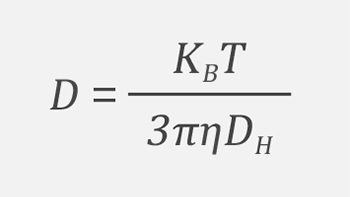
2. 173°後方光散乱検出技術と最適な検出位置のインテリジェント調整
173°の後方光散乱量は90°の光散乱量に比べ8~10倍大きくなり、以下のメリットがあります。
-
- 非常に薄いサンプル濃度(0.1ppm)の高精度測定
- 多重散乱を回避し、40%w/vの高濃度まで測定可能
- 埃の干渉効果の抑制
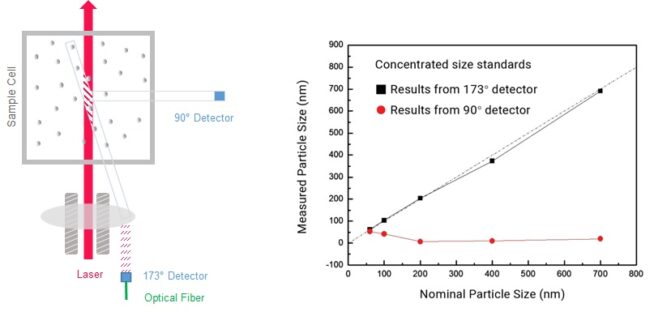
実際上記のグラフで高濃度標準サンプルの測定結果は173°検出器の測定結果と一致しています。
3. DLSフローモード
DLSフローモードは、複雑な多分散系の高分解能の粒子径測定結果を提供します。GPC/SECやFFFのような分離装置と組み合わせると、粒子は単分散フラクションに分離され、粒径ごとに順番にBeNano内を流れます。各フラクションの粒径は連続的に測定され、高分解能の粒度分布として合計されます。
BeNanoは、RIまたはUVシグナルの取得が可能で、バッチモード測定に比べ、アルゴリズムに依存しない、より正確な体積分布と個数分布が得られます。
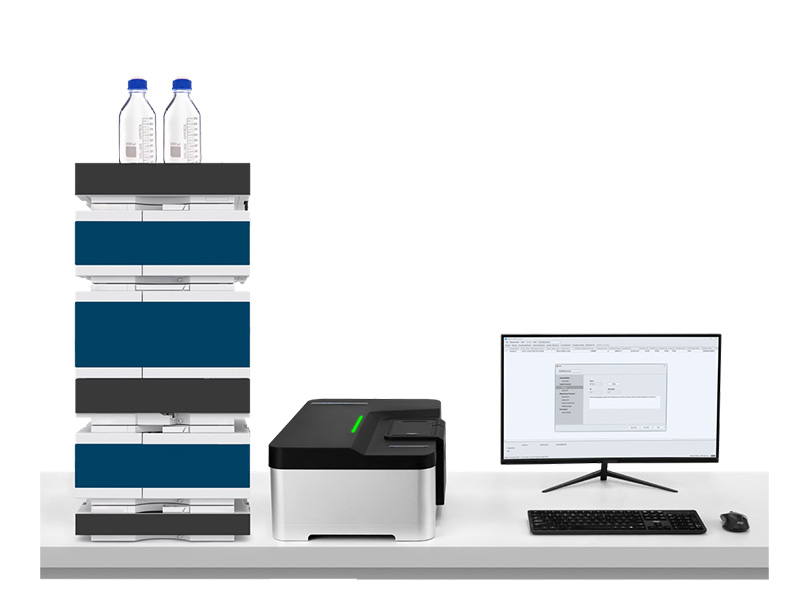
BeNanoとSECの組み合わせで、高分解能の粒子径測定結果を提供
DLSフローモード応用事例
· 粒子径と分散性に関する微粒子とポリマーの特性評価
· タンパク質のモノマー、ダイマー、凝集体の識別
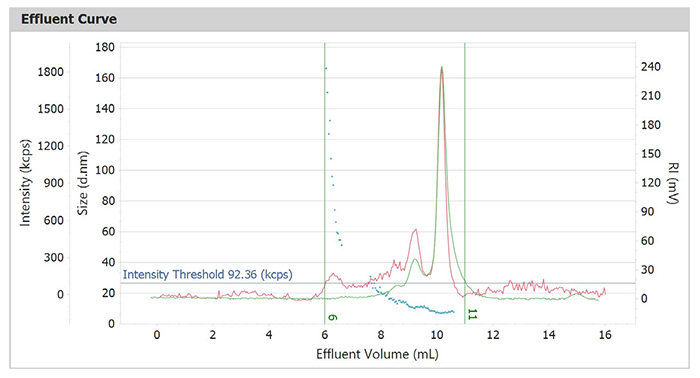
粒子径、散乱光、屈折率(RI)の曲線
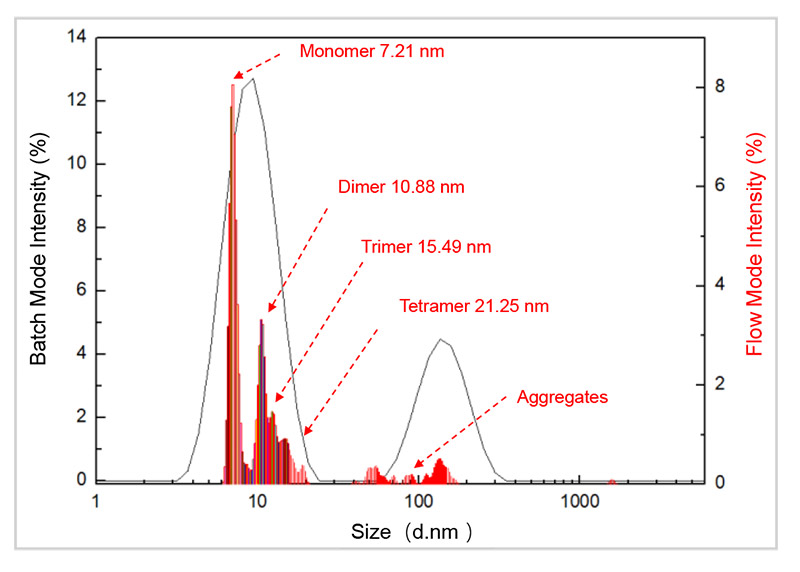
黒色の曲線:バッチモードによるBSA粒子径分布測定
赤色のヒストグラム:フローモードによるBSA粒子径分布測定
フローモードでは、バッチモードと比較して、BSA分子の粒子径や分散性に関するより正確な情報を得ることができます。
4. 高分解能の粒子径測定
特徴
-
- GPC/SEC、FFF等と接続可能なDLS装置
- RI、UV、その他の検出器からのシグナルを受信可能
- 27uLの低容量フローセルでバンドブロードニングを回避
- 分解能は1.3 :1に向上させます。
- 強度分布だけでなく、個数分布と体積分布結果まで提供可能
- タンパク質、ポリマーなどの複雑な多分散系に最適
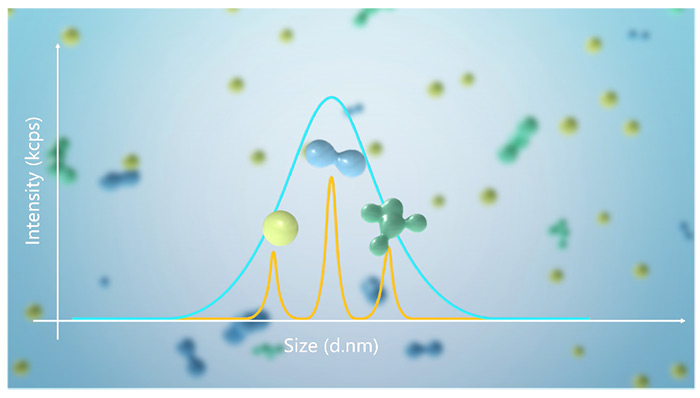
フローモードによる高分解能の粒度分布測定
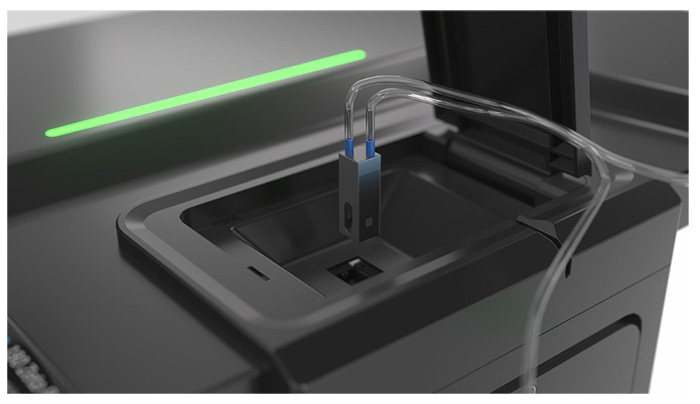
測定中、粒子がフローセール中の流れ
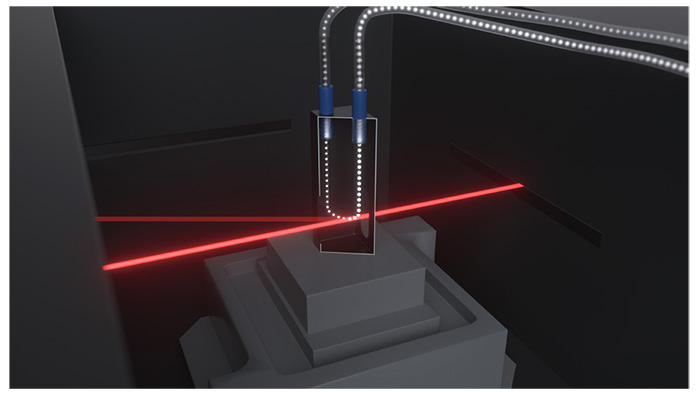
粒子分離後、粒子径を測定
5. 光散乱電気泳動法(ELS)によるゼータ電位測定
液体中に分散された粒子は、多くの場合に荷電を持っています。微粒子の場合、ゼータ電位の絶対値が増加すれば、粒子間の反発力が強くなり粒子の安定性は高くなります。逆に、ゼータ電位がゼロに近くなると、粒子は凝集しやすくなります。ゼータ電位は分散された粒子の分散安定性の指標として用いられています。光散乱電気泳動法(ELS)は、入射光と散乱光のドップラー効果による光の周波数シフトから電気泳動移動度を測定する技術です。これをヘンリーの式によって変換することで、サンプルのゼータ電位が測定されます。
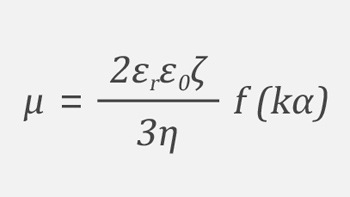
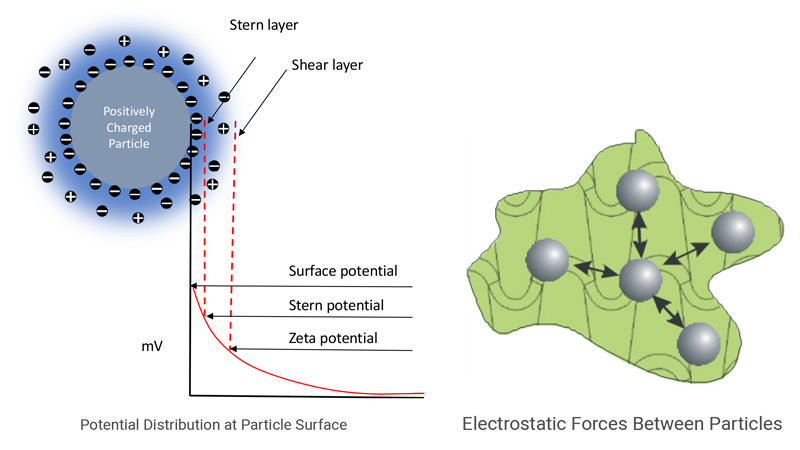
6. 位相分析光散乱(PALS)
散乱信号の位相情報Φを分析して光の周波数情報を取得する技術です。粒子のブラウン運動の影響を抑制することで高い統計精度を提供でき、等電点付近や、高塩濃度でも測定を可能にします。
メリット
-
- 電気泳動移動度の低いサンプルの測定
- 誘電率の低い有機溶媒中のサンプルの測定
- 導電率の高いサンプルでより正確な結果が得られる
- 等電点付近の粒子のゼータ電位測定

7. 静的光散乱法(SLS)
静的光散乱法(SLS)は、 レイリー方程式を使用してサンプルの散乱強度、重量平均分子量(Mw)、および第二ビリアル係数(A2)を測定する技術です。濃度をx軸として下の式をグラフにプロットしたときの切片が分子量の逆数になります。
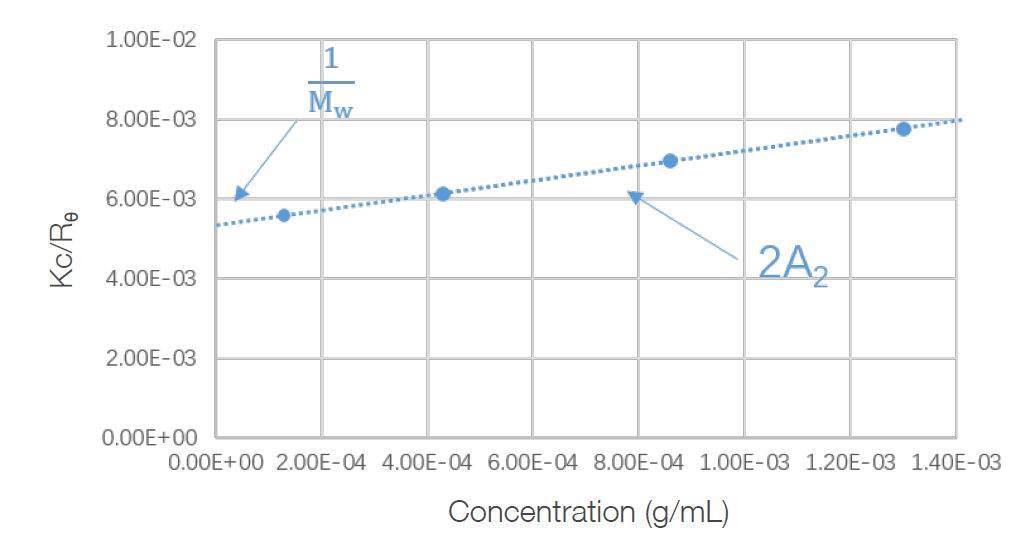
いくつかの異なる濃度の溶液を調整して、それぞれの静的光散乱量を測定し、濃度と散乱強度の逆数をプロットすることで、切片の値から分子量を求めます。
8. 動的光散乱法(DLS)によりマイクロレオロジー測定
DLSマイクロレオロジー技術を用いたBeNanoシリーズは、レーサー粒子の熱によって 起こる運動を測定することで、サンプルのレオロジー特性を経済的で効率的に測定します。

メリット
-
- 超微量サンプルで測定可能
- メカニカルレオロジーの結果を補完
- 構造の弱いサンプルに最適
9. 温度トレンド測定
BeNanoによる粒子径測定とゼータ電位測定では、-15℃から110℃の範囲で、温度変化による傾向を自動で測定することが可能です。
測定可能なパラメータ
-
- 粒子径 vs 温度
- ゼータ電位 vs 温度
応用事例
-
- タンパク質製剤の安定性研究
- 高温シミュレーションによる老化促進
10. BAT-1 自動滴定装置
BAT-1自動滴定装置は、試料のpHを自動調整するためのアクセサリです。BeNanoシリーズとの組み合わせで自動滴定を行い、ゼータ電位の変化や等電点IEPの測定に最適です。
測定可能なパラメータ
-
- ゼータ電位対pH
- 等電点
- 導電率対pH
メリット
-
- 初期pHと目標pHを設定し、自動滴定を行う
- 短時間で測定完了
- 研究者の作業負担を軽減
Citations
- Bettersizer 2600
Functional redundancy as an indicator for evaluating functional diversity of macrobenthos under the mussel raft farm near Gouqi Island
DOI: 10.1016/j.aquaculture.2023.740024 Read ArticleZhejiang Ocean University | 2024Biological traits analysis (BTA) helps to evaluate the effects of different environmental variables on the traits-based functional composition of macrobenthos. However, research on functional traits of macrobenthos under mussel farming is limited. We investigated the spatial and temporal response of the benthic system in terms of taxonomic and functional diversity to environmental variables of farming and natural stressors resulting from suspended mussel farming near Gouqi Island of eastern China Sea. The functional traits of macrobenthic assemblages under mussel farming were characterized by “medium adult body size”, “vermiform body form”, “high flexibility”, “infauna”, “semi-motile”, “gonochoristic”, “surface deposit-feeders”, “carnivores”, “semi-motile burrowers”, and “tube-dwellers”. Functional redundancy was stable in response to mussel farming stresses among seasons, whereas species diversity showed efficient to evaluate natural variables. Functional diversity was significantly affected by farming stressors rather than natural variables, Further analysis using multivariate methods together with continuous monitoring were highlighted to evaluate the impacts of mussel farming. Our results reinforce the importance of macrobenthic species and functional traits analysis to evaluate human stresses driven impacts in offshore ecosystems. By analysing the environmental variables with different sources, independently, we concluded the main effects of human pressures on macrobenthic community. Such distinction could be particularly effective to isolate variable environmental descriptors and evaluate their effects on functional diversity, making the current approach promising for the evaluation of ecological effects of anthropogenic stressors in aquaculture areas. - Bettersizer 2600
Degradation characteristics and utilization strategies of a covalent bonded resin-based solid amine during capturing CO2 from flue gas
DOI: 10.1016/j.seppur.2023.125621 Read ArticleChina University of Petroleum | 2024In this study, various types of degradation as well as attrition which are possibly encountered in a circulating fluidized bed temperature swing adsorption (CFB-TSA) process, were conducted experimentally to evaluate the stability of a resin-based solid amine sorbent. Other characterizations methods, such as elemental analysis (EA), Fourier transform infrared spectroscopy (FTIR) etc. were applied to further reveal the degradation mechanisms. The results showed that thermal degradation occurs from 140–160 °C due to the decomposition of amine group. The CO2-induced degradation occurs from a higher temperature of 160–180 °C accompanied by the production of urea. Hydrothermal stability is good below 130 °C, but the ionic impurities in steam crystalized on particle surface can accelerate the degradation. Oxidative degradation is the most harmful, which starts at a lower temperature of 70–80 °C with the formation of aldehyde. The existence of H2O in atmosphere can alleviate the oxidative and CO2-induced degradations. The employed sorbent has a very low attrition index of 0.05, which is 1–2 orders lower than typical commercial fluidized bed catalysts. Based on the results of stability evaluation, some design suggestions for proper utilization of this sorbent or other similar resin-based sorbents have been provided in an industrial CFB-TSA process.
- Bettersizer 2600
De-branching of starch molecules enhanced the complexation with chitosan and its potential utilization for delivering hydrophobic compounds
DOI: 10.1016/j.foodhyd.2023.109498 Read ArticleShihezi University | 2024The current study aimed to prepare the complexes between debranched-waxy corn starch and chitosan polymers (DBS-CS), and then investigated their corresponding structural characteristics, rheological property and potent application in Pickering emulsion. The results indicated that the existence of chitosan significantly inhibited starch short-range molecular rearrangement for all DBS-CS samples, which was manipulated by both debranching treatment and chitosan content. Interestingly, this is the first study to reveal that the outstanding peak at 1.8 ppm in 1H NMR spectrum for sample DBS-CS was gradually shifted towards a lower-field region following an increased chitosan content. Moreover, the debranching treatment shifted the crystallinity pattern from A-type to B-type and the relative crystallinity of DBS-CS decreased gradually with the increased content of CS. All samples had a pseudoplastic fluid and shear-thinning behavior with an enhanced shear resistance following the complexation. The DBS-CS was applied in a Pickering emulsion for showing a greater emulsifying stability and a lower gel strength than native NS-CS prepared emulsion. Importantly, the encapsulation ability of curcumin in the DBS-CS emulsion was significantly improved, followed by an increase of 15.45% for its corresponding bioavailability compared to the control. Therefore, this study might highlight a potential carrier for delivering the bioactive substances in a green pattern. - Bettersizer 2600
Heat-induced aggregation behavior of wheat gluten after adding citrus pectin with different esterification degree
DOI: 10.1016/j.foodhyd.2023.109420 Read ArticleGansu Agricultural University | 2024Wheat gluten aggregation during heat treatment is beneficial to the final quality of gluten-based products. Exogenous pectin can affect gluten aggregation. However, the effect of pectin with different degrees of esterification on the heat-induced aggregation behavior of gluten and its possible mechanism are still unclear. Thus, the heat-induced aggregation behavior of gluten after adding pectin with different esterification degree was studied in this study. When the temperature was raised from 25 °C to 95 °C, pectin affected gluten aggregation and was related to the degree of esterification. Specifically, the results of rheological properties and particle size indicated that low-ester pectin improved the viscoelasticity of gluten and promoted gluten aggregation. Thermal properties revealed that enthalpy of gluten added with low-ester pectin (37%) increased from 92.96 J/g to 95.40 J/g during heating process. Structurally, the fluorescence intensity and surface hydrophobicity of gluten added with low-ester pectin (37%) were lower than those added with high-ester pectin (73%). In addition, low-ester pectin (37%) significantly increased the disulfide bond content (from 15.31 μmol/g to 18.06 μmol/g) and maintained β-sheet content of gluten compared with gluten alone at 95 °C, indicating that low-ester pectin was more likely to induce gluten aggregation. However, scanning electron microscope showed that the gluten added with low-ester pectin (46%) exhibited a denser network structure at 95 °C than that added with low-ester pectin (37%). These results will provide a theoretical base for the regulation of gluten aggregation and the quality of gluten-based products by pectin with different esterification degree.
- 1
- 2
- 3
- 4
- 5
- 6
- 84
厳選されたリソース
お客様のお声


BeNano 180 Zeta Pro
粒子径、ゼータ電位、分子量、レオロジー特性は、ナノ粒子評価における重要な指標です。最先端技術を搭載したナノ粒子分析装置BeNanoシリーズにより、ナノ粒子の評価をより高感度、高精度に測定します。






